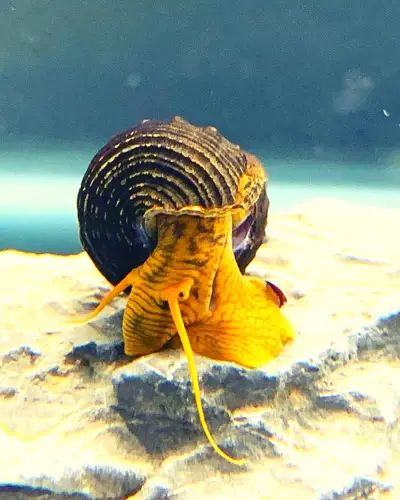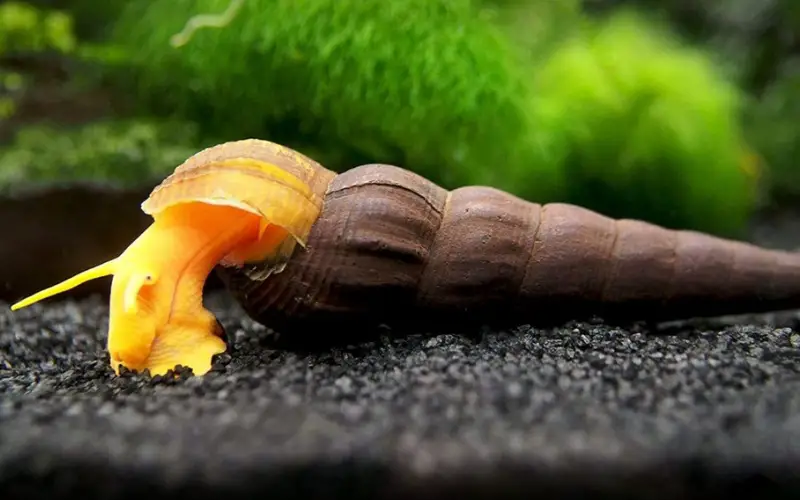Orange Giant Sulawesi Rabbit Snails are fascinating creatures that require specific care to thrive in a home aquarium. Native to the rivers and streams of Sulawesi, Indonesia, these snails are prized for their striking orange shells and unique rabbit-like faces.
Keeping these snails healthy and happy can be a rewarding experience for any aquarist, but it’s important to understand their specific needs and requirements.
This comprehensive care guide will cover everything you need to know about caring for the Orange Giant Sulawesi Rabbit Snail tylomelania gemmifera.
From tank setup and water parameters to diet and breeding tips, we will provide you with the knowledge and resources to ensure your snails thrive in their environment.

Whether you’re a beginner or an experienced aquarist, this guide is a must-read for anyone looking to add these stunning creatures to their aquatic collection.
Table of Contents
ToggleGiant Sulawesi Rabbit Snails Species Overview:
The Giant Sulawesi Snail is a stunning and unique freshwater species that has become popular in the aquarium hobby. Also known as Tylomelania Gemmifera, these gentle creatures are among the largest freshwater snails in the world.
With the peaceful nature of the rabbit snails and striking coloration, the rabbit snail is sure to impress viewers. These elephant-faced creatures came to us from freshwater lakes and are safe to keep in a planted aquarium.

One of the key features of the Giant Sulawesi rabbit snail is its orange and dark brown body with a white crown, making it a visually stunning pet to add to any freshwater tank.
Another interesting aspect of the rabbit snail is its live arrival guarantee when you purchase them online. As adult snails, they can grow to be quite large, making them a great addition to any tank.
These peaceful white-spotted snails are known to contain plant matter in their diet, and you can supplement them with a pellet specifically made for aquatic mollusks. Customer reviews of the Giant Sulawesi rabbit snails are overwhelmingly positive, with many praising their beauty and safe interactions with fish and shrimp.
Giant Sulawesi Rabbit Snail Physical Characteristics & Natural Habitat
The Giant Sulawesi Elephant Snail is a fascinating and visually striking freshwater snail endemic to the lakes of Sulawesi, Indonesia. Here’s a closer look at their physical characteristics:
Shell:
- Shape & Size: The most distinctive feature is their elongated shell, resembling a rabbit’s ear, hence the name. They can grow quite large, with some reaching up to 5 inches in length.
- Coloration: Their shells exhibit a variety of colors and patterns, including yellow, brown, black, and even albino. Stripes and banding patterns are common.
- Texture: The shell surface is generally smooth, with visible growth lines.
Body:
- Color: The snail’s body is typically dark grey or black.
- Operculum: They possess a corneous operculum, a hard plate that seals the shell opening when the snail retreats inside for protection.
- Foot: Their foot is large and muscular, enabling them to move along surfaces and burrow into the substrate.
Additional Features:
- Sexual Dimorphism: It can be difficult to differentiate between males and females by appearance alone.
- Eyes: Located at the base of their long tentacles, their eyes help them sense light and dark.
Variations:
The Giant Sulawesi Rabbit Snail has several variations, each with slightly different characteristics, especially concerning shell color and patterns. Some popular snails in the aquarium hobby include:
- Yellow Rabbit Snail: Featuring a vibrant yellow shell, often with darker banding patterns.
- Gold Rabbit Snail: Exhibits a beautiful golden or orange shell color.
- Black Rabbit Snail: As the name suggests, this variation has a predominantly black shell.
Overall, the Giant Sulawesi Rabbit Snail is a visually stunning and intriguing freshwater snail species, making them a popular choice among aquarium enthusiasts.
Giant Sulawesi Rabbit Snail Behavior and Diet
Giant Sulawesi rabbit snails are one of the largest freshwater snails, and their peaceful nature makes them a perfect addition to a community tank. Their striking orange color adds a beautifully unique touch to any aquaticmotiv setup.
These snails feed on leftover food and any fish food that falls to the substrate, making them a helpful cleanup crew for your aquarium. The giant Sulawesi rabbit snail’s behavior and diet are also influenced by their need for room to move.
It’s a good idea to avoid dense vegetation or overcrowding in your aquarium to give them space to roam and avoid any stress-related issues. These snails have also been known to munch on detritus and algae, making them a mini “cleaning crew” for your tank.
Sulawesi Snail Care and Maintenance (for Responsible Keepers)
Caring for Sulawesi snails, with the Giant Rabbit Snail being the most popular, requires specific attention to their unique needs. Here’s what you need to know:
Tank Requirements:
- Tank Size: Due to their potential size, a minimum of 20 gallons is recommended for a single snail, with additional space needed for more.
- Water Parameters: Maintaining stable water conditions is crucial. Aim for:
- Temperature: 77-84°F (25-29°C)
- pH: 7.8-8.5
- Hardness: 15-25 dGH
- Filtration & Aeration: Good filtration is essential to keep the water clean, but avoid strong currents, as Sulawesi snails prefer calmer waters. Supplement with an air stone for extra oxygenation.
- Substrate: Use a fine sand or smooth gravel substrate that won’t irritate their soft bodies.
- Decorations: Provide hiding places like caves, rocks, and driftwood. Live plants can be included, but choose hardy varieties as snails may nibble on them.
Water Quality:
- Regular Water Changes: Perform 20-30% weekly water changes to maintain optimal water quality and remove waste build-up.
- Avoid Copper: Copper is toxic to snails, so avoid any medications or fertilizers containing copper.
Giant Sulawesi Rabbit Snail Diet:
- Algae Grazers: Sulawesi snails are primarily algae eaters. Ensure good algae growth on rocks and tank surfaces for them to graze on.
- Supplemental Food: Supplement their diet with blanched vegetables like zucchini, spinach, and kale. Occasionally offer sinking algae wafers or calcium-rich foods to promote shell health.
Compatibility with Other Tankmates:
- Peaceful Community: Sulawesi snails are calm and do well with other non-aggressive tank mates like small fish and shrimp.
- Avoid Predators: Keep them away from known snail predators such as pufferfish or loaches.
Breeding Giant Rabbit Snail
- Livebearers: Sulawesi snails are livebearers, giving birth to fully formed miniature snails.
- Slow Reproduction: They have a slow reproduction rate, with females producing only a few offspring at a time.
Additional Considerations:
- Acclimation: Slowly acclimate new snails to your tank water to avoid shock.
- Handling: Minimize handling as their shells are delicate and can be easily damaged.
By following these care guidelines, you can provide a healthy and thriving environment for your Sulawesi snails, allowing them to exhibit their unique beauty and fascinating behaviors.
Orange Giant Sulawesi Snails Common Health Issues
Yellow Giant Sulawesi snails are one of hardy creatures, but like any other aquarium inhabitant, they can be susceptible to certain health issues if their environment isn’t properly maintained. Here are some of the common health problems that can affect Orange Giant Sulawesi Snails:
Shell Problems:
- Cracking or chipping: This can be caused by rough handling, fighting with other tank mates, or a calcium deficiency in the water.
- Holes: Holes in the shell can be caused by predators, such as crayfish or aggressive fish, or by fluctuations in water chemistry.
- Detritus build-up: Detritus build-up on the shell can make it difficult for the snail to breathe and can also lead to infections.
Predation:
- Orange giant rabbit snails, such as loaches, puffers, and cichlids, can be eaten by fish.
Poor Water Quality:
- Poor water quality, including high ammonia, nitrite, or nitrate levels, can stress the snail and make it more susceptible to disease.
Copper poisoning:
- Copper is toxic to snails and can even be found in trace amounts in tap water. It is important to use a copper test kit to ensure that the copper level in your aquarium is safe for snails.
It is important to take action immediately if you notice any signs of illness in your Orange Giant Sulawesi Snail, such as lethargy, loss of appetite, or shell problems. The first step is to identify the cause of the problem and then take steps to correct it. In some cases, you may need to treat the snail with medication.
Commonly Asked Questions about Giant Sulawesi Rabbit Snail (FAQs)
How big are giant Sulawesi snails?
How big do rabbit snails get? Giant Sulawesi snails, aquarium giants, can grow up to 4 inches long as adults! That’s about the length of a large smartphone.
Are rabbit snails rare?
Yes, rabbit snails are rare in the aquarium hobby. Especially the Giant Rabbit Snail, a prized species for collectors.
Do Sulawesi snails eat plants?
Yes, Sulawesi snails are omnivores and will eat algae, decaying plant matter, and sometimes healthy plants, especially soft leaves.
Are rabbit snails hard to breed?
Rabbit snails are relatively easy to breed but take a slow and steady approach. They require a mature pair, good water quality, and specific food sources.
Where are rabbit snails found?
Rabbit snails, known as Tylomelania Gemmifera, are endemic to Sulawesi, Indonesia. This means they’re native to this island and aren’t found in the wild elsewhere.
What do giant land snails eat?
Giant land snails are mostly herbivores, munching on leaves, fruits, and veggies. Some species even have a taste for fungus and carrion!
Final Thoughts
In conclusion, the mesmerizing world of aquariums has gained a new star— the magnificent giant Sulawesi rabbit snail. These captivating creatures have taken the aquatic hobbyist community by storm with their vibrant colors and unique characteristics. Whether you’re a seasoned aquarist or a curious beginner, these snails bring an exquisite touch to any tank, delighting the eye and the mind. So, if you’re ready to embark on an underwater adventure like no other, don’t miss the chance to welcome the enchanting presence of giant Sulawesi rabbit snails into your aquatic haven. Dive in and discover the magic today!
You might also like
- Top 7 Exotic Types of Rabbit Snails (That Will Amaze You!)
- Freshwater Rabbit Snails Size 101: (Tank Size & Care Guide)
- Keeping Rabbit Snail with Betta Fish Happy (5 Proven Tips)
- How Do Rabbit Snails Reproduce: (Mind-Blowing Facts)
- Rabbit Snail Breeding 101: A Comprehensive Beginner’s Guide
- What Do Giant African Land Snails Eat in the Wild: (African Snail Care Sheet)
- What to Feed Your Rabbit Snails: (7 POWER Foods They LOVE!)
- How Many Rabbit Snails Per Gallon: 2 EASY Steps for Success!
- White Spotted Rabbit Snail 101: (A Comprehensive Care Guide)




